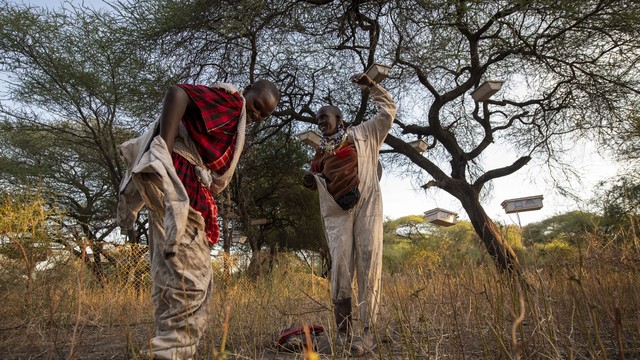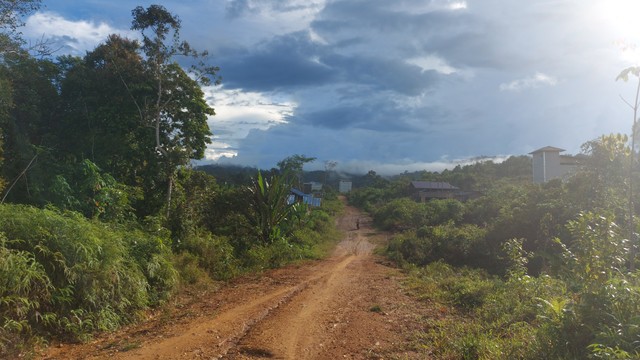Building transparency and trust into smallholder commodity trading and contract farming
Smallholder farmers have long had difficulties getting a fair price for their produce. A recent IIED webinar discussed how linking farmers to commodity exchanges and an ‘incentive-based’ contract farming (IBCF) approach can help improve farmer-buyer relations and establish more transparent trading arrangements.


Bester Glandson was lent land and taught to grow soy and groundnuts with support from the National Smallholder Farmers' Association of Malawi (NASFAM) (Photo: Olivier Girard/EIF, CC BY-NC-ND 2.0)
Smallholder farmers often struggle to achieve fair prices for their crops, especially in value chains dominated by a few large produce buyers. Getting access to agricultural commodity exchanges could enable them to sell in open and transparent markets and obtain better prices.
However, accessing those exchanges can be difficult for them because they generally produce low volumes, which are insufficient to be traded on exchanges. An incentive-based approach to contract farming – which moves away from a system that focuses on sanctioning farmers for non-compliance, to one that creates incentives for the parties to remain in the relationship – can help them overcome those barriers.
Our webinar looked at how to improve farmers’ relations with other value chain actors. We focused on an approach being trialled in Malawi to help producers to link to agricultural commodity exchanges. This approach builds on and expands previous experiences of implementing IBCF in the cotton sector.
This was the second online seminar supported through IIED’s 'Empowering Producers in Commercial agriculture (EPIC)' initiative. Our featured speakers were Cuan Opperman, team leader for the DFID-funded Malawi Oilseed Sector Transformation (MOST) programme, and Synowden Mbalafana, secretary of the Cotton Farmers Association of Malawi (COFA).
Linking farmers to agricultural commodity exchanges
Opperman described how MOST, utilising a market systems development approach, worked to help farmers overcome obstacles to accessing commodity exchanges and set up a partnership with the Agriculture Commodities Exchange for Africa (ACE) to pilot IBCF in the soybean sector.
Opperman highlighted that the scheme enabled farmers to improve access to inputs, and increase repayment records, productivity and selling prices. Input providers saw their sales increase, while it gave the commodity exchange an opportunity to increase the amount of crop traded across its platform. Importantly, the platform provided a transparent price discovery mechanism that bolstered prices for farmers who elected to place more of their crop on the platform.
Farmers repaid their loans in specified volumes of grain. Participating farmers also received good agricultural practice (GAP) training to further enhance their yields. The scheme resulted in higher incomes and improved yields among participating farmers. Farmers who paid off their debt were offered ever larger input packages in subsequent seasons as an incentive to remain in the scheme and repay their loans. Loan repayment averaged 96%.
The IBCF experience in the cotton sector
Contract farming is broadly a pre-agreed supply agreement between farmers and a buyer. The buyer in particular often provides loans to farmers so they can purchase inputs. Contract farming arrangements usually promote compliance by sanctioning default.
Many farmers have insufficient access to inputs. For buyers the biggest risks are farmers selling their produce outside of the contract farming arrangement when a third party offers a better price (known as ‘side selling’) and loan default.
Opperman and Mbalafana explained that the IBCF approach encourages the parties to work together by providing farmers incentives such as enhanced input packages, drought input insurance and funeral expenses insurance. MOST has facilitated the development of IBCF in Malawi among cotton buyers, while COFA has encouraged cotton farmers to join the scheme.
IBCF promotes long-term producer loyalty to a buyer through incentives, by providing pre-financed packages that improve each year provided the contract has been fulfilled.
Depending on the size of the input package, farmers were required to deliver a specified volume of cotton. Buyers also agreed to pay market prices to discourage side-selling. The buyers recovered the costs of the incentives through their margin on the delivered volumes. If farmers do default on the loan, they are excluded from the contract the following year.
Farmers can re-join the scheme after two seasons, although at the lowest level. Average repayment rates were in excess of 90% in a sector that usually records repayments below 30%.
As part of its remit, MOST had a target of 50% of women beneficiaries. In order to get the private sector on board, MOST presented market research that showed the business case for working with women, including better quality of produce and higher repayment rates. As result, at the end of the programme 52% of beneficiaries were women.
Challenges, scaling up and sustainability of the initiative
IBCF does face challenges, including the high cost of inputs, ‘ghost’ farmers and farmers who fail to repay loans. Farmers needing cash to buy food can also be an issue and the timing of payment (usually at harvest time) is therefore key to avoid side-selling.
However, overall, the number of participating farmers benefiting from an improved income far exceeded MOST’s initial targets. MOST’s initiative in Malawi came to an end in November 2018, but the market systems development approach to contract farming will be scaled up in Malawi with other donors and is being replicated elsewhere.
The presentations by Cuan Opperman and Synowden Mbalafana are available on IIED's SlideShare site, while a recording can be viewed below and on IIED's YouTube channel.
Future EPIC webinars will explore other strategies through which rural producers can strengthen their position in relation to other value chain actors, safeguard their rights and improve their livelihoods.
EPIC aims to empower rural producers and their wider communities to influence public decisions and private sector conduct in favour of bottom-up, locally beneficial and more sustainable investments in commercial agriculture.
EPIC is funded by UK Aid from the UK government through its Commercial Agriculture for Smallholders and Agribusiness (CASA) programme. CASA seeks to increase economic opportunities for smallholders by demonstrating the commercial viability of businesses with significant smallholder supply chains and by attracting more investment into the sector.
- Read more: our previous EPIC webinar discussed ways to protect and support farmers when negotiating with companies.
About the author





